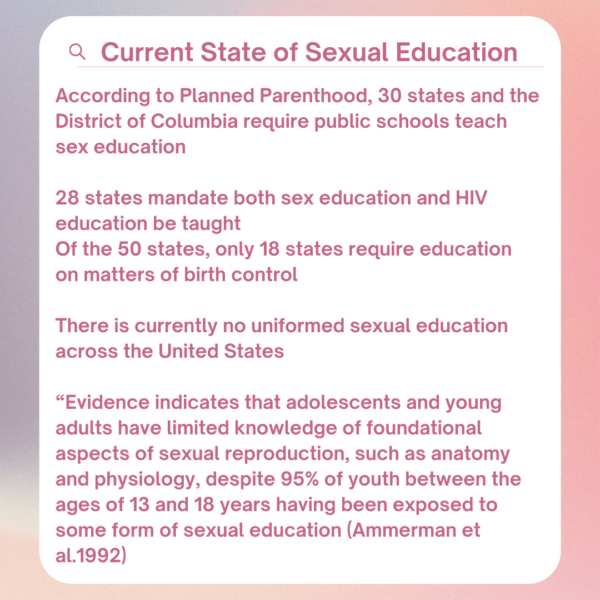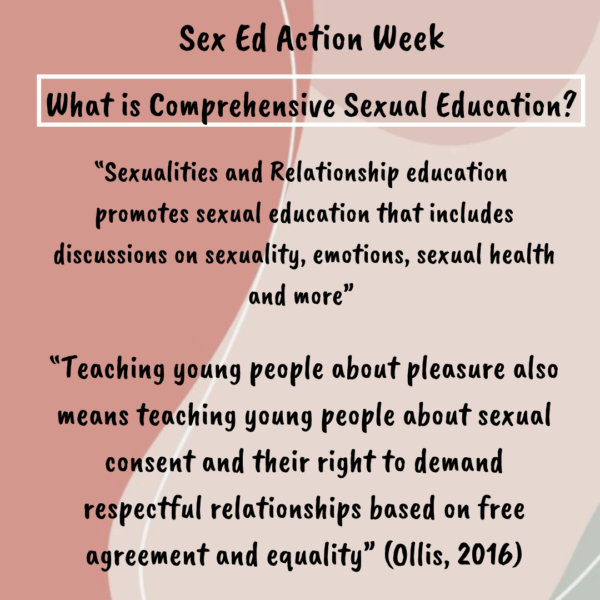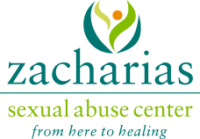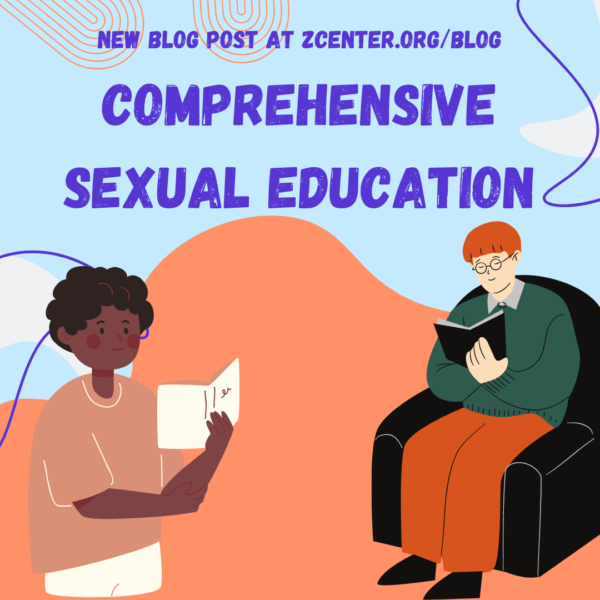 Education plays a large role in our understanding of the world. It can often lay a foundation for our perceptions of the world. Yet, at the same time, there can be considerable gaps in education that students look to fill. An example of this is within sexual education in high schools. Sexual education has long been a point of tension within school districts. For some districts, it is abstinent only sex education, where students are to refrain from sexual intercourse. Other districts focus on consent. The overall result of this tension point is that there is a gap between what students are learning and what they want to learn. This is demonstrated by the findings from Louisa Allen’s “Closing Sex Education’s Knowledge/Practice Gap: The reconceptualization of young people’s sexual knowledge,” which show that there are two ways that young people, ages 17-19 conceptualize sexual knowledge (Allen, 2001). The first way is information that comes from secondary sources, such as sexual education (Allen, 2001). The second way is from actual experiences with sex (Allen, 2001). Yet, students and young people are receiving their sexual education, not just in the classroom, but in multiple different ways.
Education plays a large role in our understanding of the world. It can often lay a foundation for our perceptions of the world. Yet, at the same time, there can be considerable gaps in education that students look to fill. An example of this is within sexual education in high schools. Sexual education has long been a point of tension within school districts. For some districts, it is abstinent only sex education, where students are to refrain from sexual intercourse. Other districts focus on consent. The overall result of this tension point is that there is a gap between what students are learning and what they want to learn. This is demonstrated by the findings from Louisa Allen’s “Closing Sex Education’s Knowledge/Practice Gap: The reconceptualization of young people’s sexual knowledge,” which show that there are two ways that young people, ages 17-19 conceptualize sexual knowledge (Allen, 2001). The first way is information that comes from secondary sources, such as sexual education (Allen, 2001). The second way is from actual experiences with sex (Allen, 2001). Yet, students and young people are receiving their sexual education, not just in the classroom, but in multiple different ways.
The first step in understanding this gap is to understand that there had long been a debate about how sexual education should be taught. There is a debate about whether sexual education should emphasize the risks of sex or stating that teen sex is normal and ensuring it is taught to be safe and responsible (Gordon & Ellingson, 2006). According to the data from Planned Parenthood Action Fund, 37 states have laws requiring abstinence be included in lessons (Planned Parenthood). Only 18 states require educators to educate on the matters of birth control (Planned Parenthood). There is not a uniformed sexual education program throughout the United States, which means that students all over the country are learning different things about sex. The Sexuality Information and Education Council of the United States (SIECUS) has long been advocating the sexual activity focuses on the message that “sexuality is a joyful, integrative, and natural part of being human” (Gordon & Ellingson, 2006).
 Yet, a majority of students are receiving what is known as “official sexual education.” This official sexual education focuses on risk mitigation, focusing on Sexual Transmitted Diseases and Infection prevention (Ollis, 2016). Overall, when students were asked about sex, they were not talking about “official sex,” such as Sexual Transmitted Infections or pregnancy prevention, but rather they are talking through their own experiences and what sex means to them (Allen, 2001). The ‘So What’s an Abstinence Anyway?’ lesson had the least variation in interpretation: 90% of the students determined that the danger messages were most dominant. Even in this case, however, the remaining 10% of participants were split between pleasure and equal/unbiased messages” (Gordon & Ellingson, 2006). The current forms of education that are valued when it comes to sexual education is that which “prescribes appropriate behavior rather than knowledge” (Allen, 2001). Even with teaching students every aspect of sexual intercourse, from risk mitigation to consent, students will often bring their own “interpretations based on gender, race, class, sexual orientation, and youth’ (Gordon & Ellingson, 2006). Yet, a well-rounded sexual education could prevent future beliefs in rape myths if done properly. The Sexual Education Forum encourages Sexualities and Relationship education that promotes sexual education that includes discussions on sexuality, emotions, sexual health and more (8). Santelli
Yet, a majority of students are receiving what is known as “official sexual education.” This official sexual education focuses on risk mitigation, focusing on Sexual Transmitted Diseases and Infection prevention (Ollis, 2016). Overall, when students were asked about sex, they were not talking about “official sex,” such as Sexual Transmitted Infections or pregnancy prevention, but rather they are talking through their own experiences and what sex means to them (Allen, 2001). The ‘So What’s an Abstinence Anyway?’ lesson had the least variation in interpretation: 90% of the students determined that the danger messages were most dominant. Even in this case, however, the remaining 10% of participants were split between pleasure and equal/unbiased messages” (Gordon & Ellingson, 2006). The current forms of education that are valued when it comes to sexual education is that which “prescribes appropriate behavior rather than knowledge” (Allen, 2001). Even with teaching students every aspect of sexual intercourse, from risk mitigation to consent, students will often bring their own “interpretations based on gender, race, class, sexual orientation, and youth’ (Gordon & Ellingson, 2006). Yet, a well-rounded sexual education could prevent future beliefs in rape myths if done properly. The Sexual Education Forum encourages Sexualities and Relationship education that promotes sexual education that includes discussions on sexuality, emotions, sexual health and more (8). Santelli
According to the SIECUS, if students cannot articulate what they are looking for in a sexual relationship, then they will not be able to articulate consent or non-consent (Gordon & Ellingson, 2006).. This becomes especially prominent when analyzing the gap. This gap can be filled by family, their churches, their peers, their older siblings, and many more. Yet, the overwhelming majority of students are turning to pornography as a way to learn about the themes and topics that they are not learning about in the classroom. These themes include, sexual pleasure, sexual anatomy, and the mechanics of sex. A majority of people between 13 and 18 years old have limited knowledge of the basics of sexual reproduction, even though 95% of that population have been through some form of sexual education (Hesse & Pedersen, 2017). The knowledge that students want to know is not taught in the classrooms (Allen, 2001).
Comprehensive Sexual Education is an important form of early intervention for Preventing Sexual Assault. These conversations with our youth are imperative in the fight to end sexual violence.
For more information on comprehensive sexuality education services offered by ZCenter, please contact info@zcenter.org.
Gordon, L. E., & Ellingson, L. (2006). In the eyes of the beholder: Student interpretations of sexuality lessons. Sex Education, 6(3), 251–264. https://doi.org/10.1080/14681810600836364
Lyndon, A. E., Duffy, D. M., Smith, P. H., & White, J. W. (2011). The role of high school coaches in helping prevent adolescent sexual aggression: Part of the solution or part of the problem? Journal of Sport & Social Issues, 35(4), 377–399. https://doi.org/10.1177/0193723511426292
Watson, M. A., & Smith, R. D. (2012). Positive porn: Educational, medical, and clinical uses. American Journal of Sexuality Education, 7(2), 122–145. https://doi.org/10.1080/15546128.2012.680861
Ollis, D. (2016). ‘I felt like I was watching porn’: The reality of preparing pre-service teachers to teach about sexual pleasure. Sex Education, 16(3), 308–323. https://doi.org/10.1080/14681811.2015.1075382
Hare, K. A., Gahagan, J., Jackson, L., & Steenbeek, A. (2015). Revisualising ‘porn’: How young adults’ consumption of sexually explicit Internet movies can inform approaches to Canadian sexual health promotion. Culture, Health & Sexuality, 17(3), 269–283. https://doi.org/10.1080/13691058.2014.919409
Sharma, M. K., Anand, N., Thamilselvan, P., Suma, N., John, N., Sahu, M., Thakur, P. C., Baglari, H., & Singh, P. (2019). Is porn use becoming a modality of sex education among teenagers? A case study. Asian Journal of Psychiatry, 45, 18–19. https://doi.org/10.1016/j.ajp.2019.08.001
Hesse, C., & Pedersen, C. L. (2017). Porn sex versus real sex: How sexually explicit material shapes our understanding of sexual anatomy, physiology, and behaviour. Sexuality & Culture: An Interdisciplinary Quarterly, 21(3), 754–775. https://doi.org/10.1007/s12119-017-9413-2
Allen, L. (2001). Closing sex education’s knowledge/practice gap: The reconceptualisation of young people’s sexual knowledge. Sex Education, 1(2), 109–122. https://doi.org/10.1080/14681810120052542
Hare, K. A., Gahagan, J., Jackson, L., & Steenbeek, A. (2015). Revisualising ‘porn’: How young adults’ consumption of sexually explicit Internet movies can inform approaches to Canadian sexual health promotion. Culture, Health & Sexuality, 17(3), 269–283. https://doi.org/10.1080/13691058.2014.919409
Hirst, J. (2013). ‘It’s got to be about enjoying yourself’: Young people, sexual pleasure, and sex and relationships education. Sex Education, 13(4), 423–436. https://doi.org/10.1080/14681811.2012.747433
Rohrbach, L. A., Berglas, N. F., Jerman, P., Angulo-Olaiz, F., Chou, C.-P., & Constantine, N. A. (2015). A rights-based sexuality education curriculum for adolescents: 1-year outcomes from a cluster-randomized trial. Journal of Adolescent Health, 57(4), 399–406. https://doi.org/10.1016/j.jadohealth.2015.07.004
Santelli, J. S., Grilo, S. A., Choo, T.-H., Diaz, G., Walsh, K., Wall, M., Hirsch, J. S., Wilson, P. A., Gilbert, L., Khan, S., & Mellins, C. A. (2018). Does sex education before college protect students from sexual assault in college? PLoS ONE, 13(11).
deFur, K. M. (2012). Don’t forget the good stuff! Incorporating positive messages of sexual pleasure into sexuality education. American Journal of Sexuality Education, 7(2), 160–169. https://doi.org/10.1080/15546128.2012.681214
Peter, C. R., Tasker, T. B., & Horn, S. S. (2015). Parents’ attitudes toward comprehensive and inclusive sexuality education: Beliefs about sexual health topics and forms of curricula. Health Education, 115(1), 71–92. https://doi.org/10.1108/HE-01-2014-0003
Adeoye, H., & Odebowale, I. (2014). Sexuality education and contraception as correlates of sexual behaviour among university undergraduates. Gender & Behaviour, 12(1), 6125–6134.
Jeffries, W. L., Dodge, B., Bandiera, F. C., & Reece, M. (2010). Beyond abstinence-only: Relationships between abstinence education and comprehensive topic instruction. Sex Education, 10(2), 171–185. https://doi.org/10.1080/14681811003666317
Written by Cassidy Herberth, Prevention and Education Specialist.
ZCenter aims to end sexual violence, mobilize and educate the public, and support survivors of sexual assault. Our blog addresses issues related to ending oppression and violence, since all oppression and violence are intersectional with sexual violence. All ZCenter blog posts are written by state certified staff, interns, and volunteers. For questions on authorship or content, please email info@zcenter.org.

